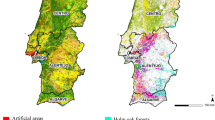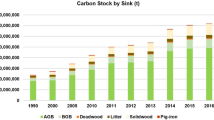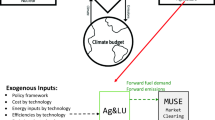Abstract
Afforestation and reforestation can contribute to the mitigation of climate change by increasing forested areas that can actively sequester carbon dioxide from the atmosphere through photosynthesis. The purpose of this study was to assess the potential for carbon sequestration in the ecosystem and in harvested wood products, and associated greenhouse gas (GHG) emission mitigation, following the application of afforestation/reforestation strategies on unproductive lands in the Province of Quebec over an 80-year long period (2021–2101), using the Carbon Budget Model of the Canadian Forester Sector 3. Afforestation/reforestation scenarios without harvesting and scenarios based on establishment of fast-growing species such as hybrid poplar showed the greatest short-term (2020–2040) carbon sequestration potential. Over the 80-year simulation period, plantations without harvesting generated a greater potential for carbon sequestration in ecosystems; after each harvesting event, several decades were necessary to regain any ecosystem carbon loss, which could be compensated only if a proportion of the harvested wood is converted to long-lived wood products, with high substitution effects in other sectors. In the northern boreal zone of Quebec, significant mitigation potential can be expected from the afforestation of open woodlands and poorly regenerated burns, both with or without harvesting. In the southern zone, the need for better data on vegetation succession and carbon accumulation on abandoned farmlands in the absence of plantations was highlighted by this study. This study increases the understanding of carbon sequestration by plantations, and their role as a mitigation strategy to contribute to national GHG emission reduction targets and net-zero carbon objectives.








Similar content being viewed by others
Availability of data and materials
The datasets supporting the conclusions of this article are available in the Figshare repository at: https://figshare.com/articles/dataset/Menard_et_al_Afforestation_Quebec/14879700.
Abbreviations
- A/R:
-
Afforestation/reforestation
- CBM-CFS3:
-
Carbon Budget Model of the Canadian Forest Sector
- CBM-HWP:
-
Carbon Budget Model Harvested Wood Products
- OWs:
-
Open woodlands
- HWPs:
-
Harvested wood products
References
Beauregard R, Lavoie P, Thiffault É et al (2019) Rapport du groupe de travail sur la forêt et les changements climatiques. Ministère des Forêts, de la Faune et des Parcs, Quebec
Bélanger L, Grenier M (2002) Agriculture intensification and forest fragmentation in the St. Lawrence valley, Québec. Canada Landsc Ecol 17:495–507. https://doi.org/10.1023/A:1021443929548
Bellassen V, Luyssaert S (2014) Carbon sequestration: managing forests in uncertain times. Nature 506:153–155. https://doi.org/10.1038/506153a
Benjamin K, Domon G, Bouchard A (2005) Vegetation composition and succession of abandoned farmland: effects of ecological, historical and spatial factors. Landsc Ecol 20:627–647. https://doi.org/10.1007/s10980-005-0068-2
Benjamin K, Bouchard A, Domon G (2008) Managing abandoned farmland: the need to link biological and sociological aspects. Environ Manage 42:603–619. https://doi.org/10.1007/s00267-008-9176-5
Bernier PY, Desjardins RL, Karimi-Zindashty Y et al (2011) Boreal lichen woodlands: a possible negative feedback to climate change in eastern North America. Agric for Meteorol 151:521–528. https://doi.org/10.1016/j.agrformet.2010.12.013
Bolghari B, Bertrand V (1984) Tables préliminaires de production des principales essences résineuses plantées dans la partie centrale du sud du Québec. Ministère de l’Énergie et des Ressources, Quebec
Boucher JF, Tremblay P, Gaboury S, Villeneuve C (2012) Can boreal afforestation help offset incompressible GHG emissions from Canadian industries? Process Saf Environ Prot 90:459–466. https://doi.org/10.1016/j.psep.2012.10.011
Boulanger Y, Taylor AR, Price DT et al (2016) Climate change impacts on forest landscapes along the Canadian southern boreal forest transition zone. Landsc Ecol 32:1415–1431. https://doi.org/10.1007/s10980-016-0421-7
Bright RM, Zhao K, Jackson RB, Cherubini F (2015) Quantifying surface albedo and other direct biogeophysical climate forcings of forestry activities. Glob Chang Biol 21:3246–3266. https://doi.org/10.1111/gcb.12951
Bureau du forestier en chef (2018) Calcul et détermination des possibilités forestières. Fascicule 1.2. Manuel de détermination des possibilités forestières 2018-2023. Gouvernement du Québec, Roberval, Quebec
Drever CR, Cook-Patton SC, Akhter F et al (2021) Natural Climate Solutions for Canada. Sci Adv 7:1–13. https://doi.org/10.1126/sciadv.abd6034
Dufour B, Boucher JF, Tremblay P et al (2016) Black-spruce-lichen woodlands growth and carbon drawdown potentials as revealed by mature stands. Boreal Environ Res 21:71–86
Eriksson E, Gillespie AR, Gustavsson L et al (2007) Integrated carbon analysis of forest management practices and wood substitution. Can J for Res 37:671–681. https://doi.org/10.1139/X06-257
Fady B, Davi H, Martin-StPaul N, Ruffault J (2021) Caution needed with the EU forest plantation strategy for offsetting carbon emissions. New for 52:733–735. https://doi.org/10.1007/s11056-020-09830-1
Fearnside PM, Lashof DA, Moura-Costa P (2000) Accounting for time in mitigating global warming through land-use change and forestry. Mitig Adapt Strateg Glob Chang 5:239–270. https://doi.org/10.1023/A:1009625122628
Foote RL, Grogan P (2010) Soil carbon accumulation during temperate forest succession on abandoned low productivity agricultural lands. Ecosystems 13:795–812. https://doi.org/10.1007/s10021-010-9355-0
Forster EJ, Healey JR, Dymond C, Styles D (2021) Commercial afforestation can deliver effective climate change mitigation under multiple decarbonisation pathways. Nat Commun. https://doi.org/10.1038/s41467-021-24084-x
Fradette O (2012) Croissance des stocks de carbone dix ans après boisement de terrains dénudés boréaux. Université du Québec à Chicoutimi, Quebec
Fuss S, Lamb WF, Callaghan MW et al (2018) Negative emissions—Part 2: costs, potentials and side effects. Environ Res Lett. https://doi.org/10.1088/1748-9326/aabf9f
Gaboury S, Boucher JF, Villeneuve C et al (2009) Estimating the net carbon balance of boreal open woodland afforestation: a case-study in Québec’s closed-crown boreal forest. For Ecol Manage 257:483–494. https://doi.org/10.1016/j.foreco.2008.09.037
Gauthier S, Bernier P, Kuuluvainen T et al (2015) Boreal forest health and global change. Science 349:819–822. https://doi.org/10.1126/science.aaa9092
Gillett NP, Kirchmeier-Young M, Ribes A et al (2021) Constraining human contributions to observed warming since the pre-industrial period. Nat Clim Chang 11:207–212. https://doi.org/10.1038/s41558-020-00965-9
Government of Canada (2021) 2 Billion Trees Commitment. https://www.canada.ca/en/campaign/2-billion-trees.html. Accessed 6 Dec 2022
Gustavsson L, Nguyen T, Sathre R, Tettey UYA (2021) Climate effects of forestry and substitution of concrete buildings and fossil energy. Renew Sustain Energy Rev 136:110435. https://doi.org/10.1016/j.rser.2020.110435
Hébert F, Boucher JF, Walsh D et al (2014) Black spruce growth and survival in boreal open woodlands 10 years following mechanical site preparation and planting. Forestry 87:277–286. https://doi.org/10.1093/forestry/cpt052
Hooker TD, Compton JE (2003) Forest ecosystem carbon and nitrogen accumulation during the first century after agricultural abandonment. Ecol Appl 13:299–313. https://doi.org/10.1890/1051-0761(2003)013[0299:FECANA]2.0.CO;2
Inouye RS, Huntly NJ, Tilman D et al (1987) Old-field succession on a Minnesota sand plain. Ecology 68:12–26. https://doi.org/10.2307/1938801
Intergovernmental Panel on Climate Change (2003) Good Practice Guidance for Land Use, Land-Use Change and Forestry. Penman, J., Gytarsky, M., Hiraishi, T., Krug, T., Kruger, D., Pipatti, R., Buendia, L., Miwa, K., Ngara, T., Tanabe, K. and Wagner, F., Eds., Institute for Global Environmental Strategies (IGES), Kanagawa
Intergovernmental Panel on Climate Change (2014) Climate Change 2014: Mitigation of Climate Change. Contribution of Working Group III to the Fifth Assessment Report of the Intergovernmental Panel on Climate Change [Edenhofer, O., R. Pichs-Madruga, Y. Sokona, E. Farahani, S. Kadner, K. Seyboth, A. Adler, I. Baum, S. Brunner, P. Eickemeier, B. Kriemann, J. Savolainen, S. Schlömer, C. von Stechow, T. Zwickel and J.C. Minx (eds.)]. Cambridge University Press, Cambridge, United Kingdom and New York, NY, USA
Intergovernmental Panel on Climate Change (2017) An IPCC Special Report on climate change, desertification, land degradation, sustainable land management, food security, and greenhouse gas fluxes in terrestrial ecosystems, London, UK
Jasinski JPP, Payette S (2005) The creation of alternative stable states in the southern boreal forest, Québec, Canada. Ecol Monogr 75:561–583. https://doi.org/10.1890/04-1621
Kalliokoski T, Bäck J, Boy M et al (2020) Mitigation impact of different harvest scenarios of finnish forests that account for albedo, aerosols, and trade-offs of carbon sequestration and avoided emissions. Front for Glob Chang 3:1–16. https://doi.org/10.3389/ffgc.2020.562044
Kull SJ, Rampley GJ, Morken S, et al (2014) Operational-Scale Carbon Budget Model of the Canadian Forest Sector (CBM-CFS3) user’s guide. Edmonton, Canada
Kurz WA, Apps MJ, Beukema SJ, Lekstrum T (1995) 20th century carbon budget of Canadian forests. Tellus, Ser B 47:170–177. https://doi.org/10.3402/tellusb.v47i1-2.16038
Kurz WA, Dymond CC, White TM et al (2009) CBM-CFS3: A model of carbon-dynamics in forestry and land-use change implementing IPCC standards. Ecol Modell. https://doi.org/10.1016/j.ecolmodel.2008.10.018
Laflèche V, Bernier S, Saucier J-P, Gagné C (2013) Indices de qualité de station des principales essences commerciales en fonction des types écologiques du Québec méridional ministère, ministère des Ressources naturelles. Direction des inventaires forestiers, Québec
Laganière J, Paré D, Thiffault E, Bernier PY (2017) Range and uncertainties in estimating delays in greenhouse gas mitigation potential of forest bioenergy sourced from Canadian forests. GCB Bioenergy 9:358–369. https://doi.org/10.1111/gcbb.12327
Lambert MC, Ung CH, Raulier F (2005) Canadian national tree aboveground biomass equations. Can J for Res 35:1996–2018. https://doi.org/10.1139/x05-112
Larouche C, Guillemette F, Raymond P, Saucier JP (2013) Le guide sylvicole du Québec: les concepts et l’application de la sylviculture. Les Publications du Québec, Québec
Magnan M (2013) Carbon Budget model-framework for harvested wood products (CBM–FHWP) version 1.0. Pacific Forestry Centre, Victoria, BC, Canada
Magnus GK, Celanowicz E, Voicu M et al (2021) Growing our future : assessing the outcome of afforestation programs in Ontario. Canada 97:1–12
McKinley DC, Ryan MG, Birdsey RA et al (2011) A synthesis of current knowledge on forests and carbon storage in the United States. Ecol Appl 21:1902–1924. https://doi.org/10.1890/10-0697.1
Nabuurs GJ, Delacote P, Ellison D et al (2017) By 2050 the mitigation effects of EU forests could nearly double through climate smart forestry. Forests 8:484. https://doi.org/10.3390/f8120484
Nabuurs, G.J., O. Masera, K. Andrasko, P. Benitez-Ponce, R. Boer, M. Dutschke, E. Elsiddig, J. Ford-Robertson, P. Frumhoff, T. Karjalainen, O. Krankina, W.A. Kurz, M. Matsumoto, W. Oyhantcabal, N.H. Ravindranath, M.J. Sanz Sanchez XZ (2007) Forestry. In Climate Change 2007: Mitigation. Contribution of Working Group III to the Fourth Assessment Report of the Intergovernmental Panel on Climate Change [B. Metz, O.R. Davidson, P.R. Bosch, R. Dave, L.A. Meyer (eds)], Cambridge University Press, Cambridge, United Kingdom and New York, NY, USA
Nilsson MC, Wardle DA (2005) Understory vegetation as a forest ecosystem driver: evidence from the northern Swedish boreal forest. Front Ecol Environ 3:421–428. https://doi.org/10.1890/1540-9295(2005)003[0421:UVAAFE]2.0.CO;2
Paradis L, Thiffault E, Achim A (2019) Comparison of carbon balance and climate change mitigation potential of forest management strategies in the boreal forest of Quebec (Canada). Forestry 92:264–277. https://doi.org/10.1093/forestry/cpz004
Ministère des Forêts, de la Faune et des Parcs (2015) Stratégie d’aménagement durable des forêts. Gouvernement du Québec, Quebec
Post WM, Kwon KC (2000) Soil carbon sequestration and land-use change: processes and potential. Glob Chang Biol 6:317–327. https://doi.org/10.1046/j.1365-2486.2000.00308.x
Pothier D, Savard F (1998) Actualisation des tables de production pour les principales espèces forestières du Québec. Direction de la recherche forestière, Québec
Poulin J (2013a) Éclaircie commerciale. Fascicule 3.5. Dans Bureau du forestier en chef. Manuel de détermination des possibilités forestières 2013-2018. Gouvernement du Québec, Roberval, Quebec
Poulin J (2013b) Plantation. Fascicule 3.1. Dans Bureau du forestier en chef. Manuel de détermination des possibilités forestières 2013-2018. Gouvernement du Québec, Roberval, Quebec
Prégent G, Bertrand V, Charette L (1996) Tables préliminaires de rendement pour les plantations d’Épinette noire au Québec. Mémoire Rech for 118:88
R Core Team (2020) R: A language and environment for statistical computing. R Foundation for Statistical Computing, Vienna, Austria. https://www.R-project.org/. Accessed 6 Dec 2022
Sathre R, O’Connor J (2010) Meta-analysis of greenhouse gas displacement factors of wood product substitution. Environ Sci Policy 13:104–114. https://doi.org/10.1016/j.envsci.2009.12.005
Smyth CE, Stinson G, Neilson E et al (2014) Quantifying the biophysical climate change mitigation potential of Canada’s forest sector. Biogeosciences 11:3515–3529. https://doi.org/10.5194/bg-11-3515-2014
Smyth C, Rampley G, Lemprière TC et al (2017) Estimating product and energy substitution benefits in national-scale mitigation analyses for Canada. GCB Bioenergy 9:1071–1084. https://doi.org/10.1111/gcbb.12389
Suryaningrum F, Jarvis RM, Buckley HL et al (2021) Large-scale tree planting initiatives as an opportunity to derive carbon and biodiversity co-benefits: a case study from Aotearoa New Zealand. New for. https://doi.org/10.1007/s11056-021-09883-w
Thiffault N, Roy V (2011) Living without herbicides in Québec (Canada): historical context, current strategy, research and challenges in forest vegetation management. Eur J for Res 130:117–133. https://doi.org/10.1007/s10342-010-0373-4
Thiffault N, Jobidon R, Munson AD (2003) Performance and physiology of large containerized and bare-root spruce seedlings in relation to scarification and competition in Québec (Canada). Ann for Sci 60:645–655. https://doi.org/10.1051/forest:2003057
Tremblay S, Ouimet R (2013) White spruce plantations on abandoned agricultural land: are they more effective as C sinks than natural succession? Forests 4:1141–1157. https://doi.org/10.3390/f4041141
Tremblay P, Boucher JF, Tremblay M, Lord D (2013) Afforestation of boreal open woodlands: early performance and ecophysiology of planted black spruce seedlings. Forests 4:433–454. https://doi.org/10.3390/f4020433
Ung CH, Bernier PY, Raulier F et al (2001) Biophysical site indices for shade tolerant and intolerant boreal species. For Sci 47:83–95
United Nations Framework Convention on Climate Change (2015) Report of the Conference of the Parties on its twenty-first session, held in Paris from 30 November to 13 December 2015
United Nations Framework Convention on Climate Change (2020) Emissions gap emissions gap report 2020. Nairobi
Valade A, Bellassen V, Magand C, Luyssaert S (2017) Sustaining the sequestration efficiency of the European forest sector. For Ecol Manage 405:44–55. https://doi.org/10.1016/j.foreco.2017.09.009
Voicu MF, Shaw C, Kurz WA et al (2017) Carbon dynamics on agricultural land reverting to woody land in Ontario, Canada. J Environ Manage 193:318–325. https://doi.org/10.1016/j.jenvman.2017.02.019
Werner F, Taverna R, Hofer P et al (2010) National and global greenhouse gas dynamics of different forest management and wood use scenarios: a model-based assessment. Environ Sci Policy 13:72–85. https://doi.org/10.1016/j.envsci.2009.10.004
Wickham H (2016) Ggplot2: Elegant graphics for data analysis. Springer-Verlag New York. https://ggplot2.tidyverse.org. Accessed 6 Dec 2022
Williams CA, Gu H, Jiao T (2021) Climate impacts of U.S. forest loss span net warming to net cooling. Sci Adv 7:1–6. https://doi.org/10.1126/sciadv.aax8859
Xu Z, Smyth CE, Lemprière TC et al (2018) Climate change mitigation strategies in the forest sector: biophysical impacts and economic implications in British Columbia, Canada. Mitig Adapt Strateg Glob Chang 23:257–290. https://doi.org/10.1007/s11027-016-9735-7
Yang Y, Hobbie SE, Hernandez RR et al (2020) Restoring abandoned farmland to mitigate climate change on a full earth. One Earth 3:176–186. https://doi.org/10.1016/j.oneear.2020.07.019
Acknowledgements
Authors wish to acknowledge Sylvie Tremblay from Direction de la Recherche Forestière for providing the data for abandoned farmlands; Michael Magnan, Carolyn E Smyth, and all members of the Carbon Accounting Team at the Pacific Forestry Centre and Stephen Kull from Northern Forestry Centre for the training, technical support and the data, and Yan Boucher and Jason Laflamme from Direction des Inventaires Forestiers for data for OWs and poorly regenerated burns. Warm thanks to Boris Dufour from Université du Québec à Chicoutimi and Patrick Lavoie from FPInnovations.
Funding
This work was supported by the Mitacs Acceleration Program (project number IT10419) with the partnership of FPInnovations, Laval University through a scholarship to Isabelle Ménard and an establishment grant to Evelyne Thiffault, and Université du Québec à Chicoutimi through a scholarship to Isabelle Ménard and a Natural Sciences and Engineering Research Council of Canada (NSERC) grant (Collaborative Research and Development Grants Project 488866–15) to Jean-François Boucher.
Author information
Authors and Affiliations
Contributions
IM, ET, JFB and WK conceived the approach and methods. IM drafted the paper and ran the analyses. All authors contributed to the revision of the manuscript. All authors read and approved the final manuscript.
Corresponding author
Ethics declarations
Conflict of interest
The authors have no conflict of interest to declare. All co-authors have seen and agree with the contents of the manuscript and there is no financial interest to report.
Additional information
Publisher's Note
Springer Nature remains neutral with regard to jurisdictional claims in published maps and institutional affiliations.
Supplementary Information
Below is the link to the electronic supplementary material.
Rights and permissions
Springer Nature or its licensor (e.g. a society or other partner) holds exclusive rights to this article under a publishing agreement with the author(s) or other rightsholder(s); author self-archiving of the accepted manuscript version of this article is solely governed by the terms of such publishing agreement and applicable law.
About this article
Cite this article
Ménard, I., Thiffault, E., Kurz, W.A. et al. Carbon sequestration and emission mitigation potential of afforestation and reforestation of unproductive territories. New Forests 54, 1013–1035 (2023). https://doi.org/10.1007/s11056-022-09955-5
Received:
Accepted:
Published:
Issue Date:
DOI: https://doi.org/10.1007/s11056-022-09955-5




